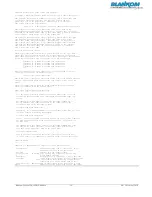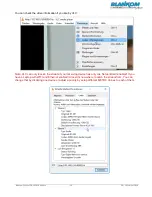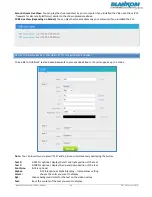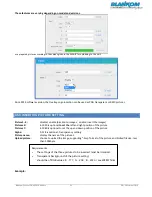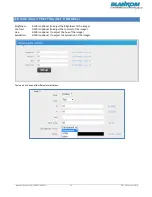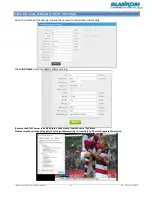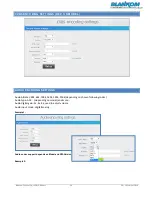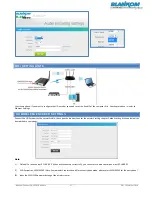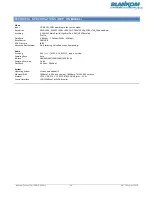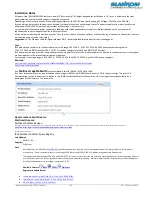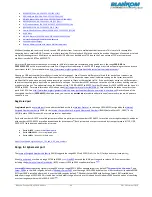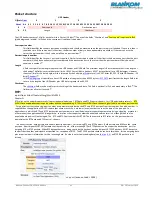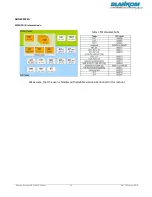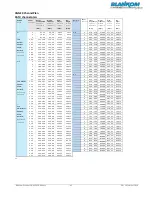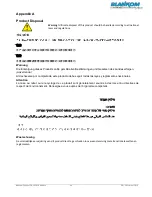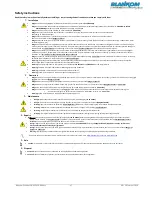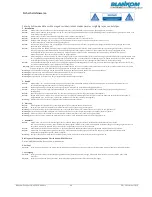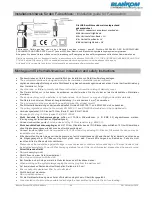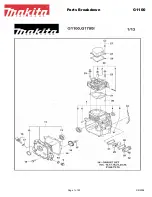
Blankom-Encoder-EN-V3-2019-RR.docx
- 40 -
RRI 26. Februar 2019
RESERVED (224.1.0.0-224.1.255.255 (224.1/16))
SDP/SAP Block (224.2.0.0-224.2.255.255 (224.2/16))
AD-HOC Block II (224.3.0.0-224.4.255.255 (224.3/16, 224.4/16))
RESERVED (224.5.0.0-224.251.255.255 (251 /16s))
DIS Transient Groups 224.252.0.0-224.255.255.255 (224.252/14))
RESERVED (225.0.0.0-231.255.255.255 (7 /8s))
Source-Specific Multicast Block (232.0.0.0-232.255.255.255 (232/8))
GLOP Block
AD-HOC Block III (233.252.0.0-233.255.255.255 (233.252/14))
Unicast-Prefix-based IPv4 Multicast Addresses
Scoped Multicast Ranges
Relative Addresses used with Scoped Multicast Addresses
Multicast (as opposed to unicast) is used to send UDP packets from 1 source to multiple destination servers. This is useful for example for
streaming from a satellite/DVB-T receiver to multiple receiving PCs for playback. Multicast can also be used on the output of an encoder to feed
multiple streaming servers. Multicast only works with UDP and is not possible with TCP due to the 2 way nature of TCP, most commonly
multicast is used with RTP and MPEG2-TS.
A multicast IP address must be chosen according to IANA information, we recommend using an address in the range
239.0.0.0 to
239.255.255.255
as this is reserved for private use. Using multicast addresses in the 224.0.0.0 range may clash with existing services and cause
your stream to fail. For more details see
http://www.iana.org/assignments/multicast-addresses/multicast-addresses.xml
Choosing a UDP port number for multicast streams is also important. Even if you use a different multicast IP for each of your streams, we
strongly recommend using different UDP port numbers as well. This is because a server and all software running on the server receives ALL
multicast traffic on an open port and extra processing is required to filter out the required traffic. If the each stream arrives on a different port,
the server can safely ignore any traffic on ports that are not open. Port numbers MUST be chosen so that don't clash with any existing services
or ephemeral ranges. The ephemeral range for Windows Vista, 7, 2008 is 49152 to 65535, for older Windows it is 1025 to 5000 and for Linux it is
32768 to 61000. For more information on Windows see
http://support.microsoft.com/kb/929851
Care should also be taken to avoid system
ports 0 to 1024. See
http://www.iana.org/assignments/service-names-port-numbers/service-names-port-numbers.xml
Generally one of the
unassigned User Ports (
1024-49151
) should be used, you can run the
netstat -abn
(as admin under windows) command to see which ports are
currently in use.
Registered port
A
registered port
is a
network port
(a sub-address defined within the
Internet Protocol
, in the range 1024–49151) assigned by the
Internet
Assigned Numbers Authority
(IANA) (or by
Internet Corporation for Assigned Names and Numbers
(ICANN) before March 21, 2001,
[1]
or by
USC/ISI before 1998) for use with a certain protocol or application.
Ports with numbers 0–1023 are called
system or well-known ports
; ports with numbers 1024-49151 are called
user or registered ports
, and ports
with numbers 49152-65535 are called
dynamic and/or private ports
.
[2]
Both system and user ports are used by transport protocols (TCP, UDP,
DCCP, SCTP) to indicate an application or service.
Ports 0–1023
– system or
well-known ports
Ports 1024–49151
– user or registered ports
Ports >49151
– dynamic / private ports
https://en.wikipedia.org/wiki/List_of_TCP_and_UDP_port_numbers
Range for Ephemeral port
The
Internet Assigned Numbers Authority
(IANA) suggests the range 49152 to 65535 (2
15
+2
14
to 2
16
−1) for dynamic or private ports.
[1]
Many
Linux kernels
use the port range 32768 to 61000.
[note 2]
FreeBSD
has used the IANA port range since release 4.6. Previous versions,
including the
Berkeley Software Distribution
(BSD), use ports 1024 to 5000 as ephemeral ports.
[2][3]
Microsoft Windows
operating systems through XP use the range 1025–5000 as ephemeral ports by default.
[4]
Windows Vista
,
Windows 7
, and
Server 2008
use the IANA range by default.
[5]
Windows Server 2003
uses the range 1025–5000 by default, until Microsoft security update MS08-
037 from 2008 is installed, after which it uses the IANA range by default.
[6]
Windows Server 2008 with Exchange Server 2007 installed has a
default port range of 1025–60000.
[7]
In addition to the default range, all versions of Windows since Windows 2000 have the option of specifying
a custom range anywhere within 1025–65535.
[8][9]

